#aya gozen
Photo
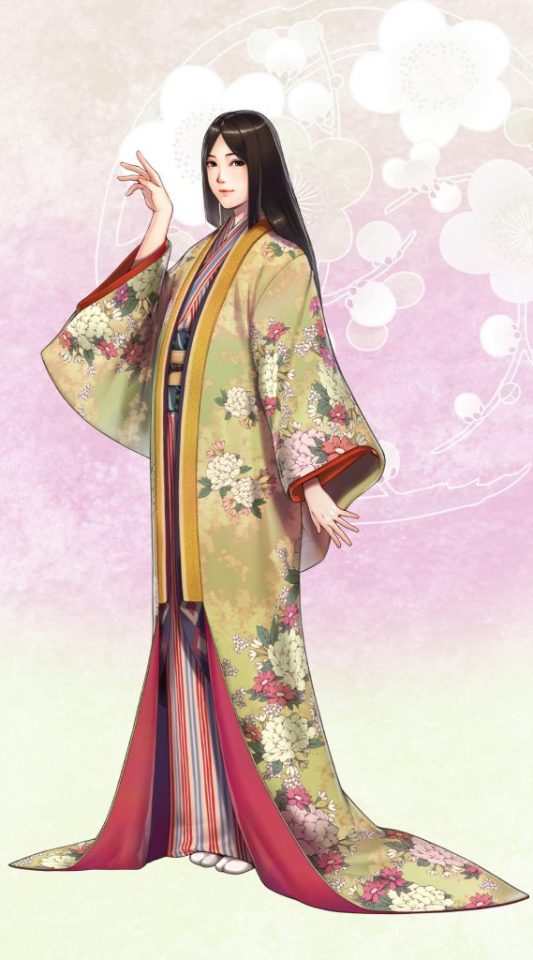
Aya Gozen, half-sister of Uesugi Kenshin by Touken World
After the death of her husband, Nagao Masakage, Aya went by the name of Sentoin. Nagao Kagetora (later known as Uesugi Kenshin) is her half-brother. She had two sons and two daughters by Nagao Masakage: her children, including, Kagekatsu, was adopted into the Uesugi Clan.
She was a highly intelligent woman and skilled in recognising talent, being responsible for employing various samurai to work for Kenshin. She recommended Naoe Kanetsugu to serve her son, Kagekatsu. It was rumored that Kanetsugu tried his best to care for her in gratitude.
#aya gozen#sentoin#uesugi kenshin#touken world#nagao masakage#nagao kagetora#uesugi kagekatsu#uesugi clan#naoe kanetsugu#sengoku jidai#japanese history#japan
16 notes
·
View notes
Text
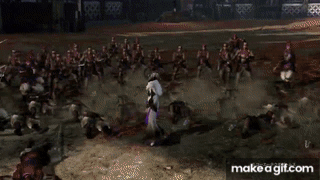
❄️ Make it rain? I’m makin’ it snow! ❄️
3 notes
·
View notes
Text
Me When i keep looking at Kastuie's SW5 Portrait

#samurai warriors#sengoku musou#samurai warriors 5#samurai warriors 4#aya-gozen#meme#shitposting#Katsuie Shibata
9 notes
·
View notes
Text
"A god of tengu-warding": uncovering the connection between Okina and tengu

There’s something uniquely magical and captivating about Okina’s dialogue in HSiFS that neither subsequent final bosses nor even her own subsequent appearances manage to capture. Probably no other character managed to directly reference quite as many myths and religious concepts in her debut game appearance. And yet, without context many of these probably seem borderline nonsensical. Interviews and supplementary material sometimes help, but even that isn’t guaranteed.
This article will focus on only one such instance, the notoriously mystifying exchange between her and Aya which simultaneously casts her as a “god of tengu-warding” and implies a degree of kinship between them. What does this mean? Why does Okina have something to do with tengu in the first place? Where do tengu come from, anyway? Why crow tengu aren’t necessarily crows? Why is it possible to make a case for Byakuren being a tengu? This - and more - will be explored under the cut.
Matarajin and tengu, from tengu odoshi to Hidden Star in Four Seasons
In Aya’s route in Hidden Star in Four Seasons, Okina calls herself “a god of tengu-warding”. This is actually not something ZUN invented. Matarajin was the focus of a medieval Tendai Buddhist ritual known as tengu odoshi (天狗怖し) - “placating the tengu”. He was most likely himself understood as a tengu in this context. As such, he had to be placated by the monks performing the ritual, whose chaotic actions - chiefly noisy recitation of random sutras coupled - were meant to imitate his own behavior.
This approach is somewhat unusual: in many other similar ceremonies an appropriate deity or deities would simply be invoked to get rid of demonic interlopers. Here the risk of obstruction is so great that only by pretending to play along with it victory can be attained. Or, alternatively, perhaps to get rid of Matarajin and other tengu, the monks had to beat them at their own game by creating an even more disorderly display. Yet another option is that Matarajin had to be attracted with the ritual in order to ward off other, lesser tengu. No matter which interpretation is correct, it is evident there was a direct connection between them.

Matarajin and his attendants (Rhode Island School of Design Museum; reproduced here for educational purposes only)
As a curiosity it’s worth pointing out that it has been suggested that tengu odoshi and other similar rituals and festivals might have resulted in the development of Matarajin’s well known role as a deity of the performing arts, especially noh, exemplified by his equation with a stock character from sarugaku, Okina, an auspicious old man represented by a characteristic bearded mask. Comparisons have also been made between the tengu odoshi and rituals involving Matarajin’s attendants Chōreita Dōji (丁令多童子) and Nishita Dōji (爾子多童子). Fittingly, one of the spell cards of their Touhou counterparts Mai and Satono is named Mad Dance "Tengu-Odoshi".

Shizuka Gozen performing in typical shirabyōshi attire, as depicted by Hokusai (wikimedia commons)
While this is only tangentially related to Matarajin, it’s worth pointing out that according to Yasurō Abe, it was also believed that tengu were enthusiasts of the performing arts in general. However, while Matarajin was associated with noh, tengu favored an earlier form of entertainment, shirabyōshi (白拍子). This term refers to a type of female dancer who performed in male formal wear. The reference to tengu enjoying their dances and songs might be an allusion to emperor Go-Shirakawa, who was known for similar artistic tastes and was commonly represented as a tengu in legends.
The association between Matarajin and tengu was also present in shugendō. In Kumano, local shugenja apparently perceived him as a tengu-like deity comparable to Iizuna Gongen (飯縄権現). It’s worth noting this is in theory who Megumu is based on, but tragically ZUN didn’t want to do much with the irl background in her case, so I doubt we'll ever see a reference to this in canon media.

An Edo period depiction of the ox festival of Matarajin (wikimedia commons)
It seems the only other possible reference to Matarajin as a tengu is a depiction of the famous (relatively speaking) Kōryū-ji ox festival from the Edo period Miyako Meisho Zue (都名所圖會) in which the person playing his role wears a tengu-like mask.
Considering ZUN has to be aware of at least some of the scholarship pertaining to Matarajin and tengu - tengu odoshi is not exactly a famous ritual, and most of the search results today are just Touhou - it seems safe to say that he had this very connection in mind. Aya mentions a category of beings she refers to as “people of impairments”, which according to her encompasses both the tengu and their metaphorical relatives who “hid behind Buddhas”, like Okina. This neatly corresponds to their shared role of their counterparts in medieval and early modern Buddhism.
In addition to the connections between Matarajin and tengu discussed above, there are multiple other instances of identifying him as a member of a category of beings usually perceived ambivalently, if not outright negatively, specifically because of their ability to impair the pursuit of enlightenment. If you read my previous post focused on Okina-adjacent topics, you already know that Matarajin was closely associated with dakinis, for instance. It’s worth noting that as an extension of this connection, he could also be associated with foxes. The Edo period treatise Inari Jinja Kō (稲荷神社考, “Reflections on Inari Shrine”) outright says that matarajin, treated as a generic term, not a given name, is one of the the terms which can be used to refer to supernatural foxes.
The oldest presently known reference to Matarajin describes him as a “yasha deity” (夜叉神, yashajin). This term is a loan from Sanskrit yakṣa, and refers to a class of nature spirits or low-ranking deities incorporated into Buddhism from preexisting tradition of India. They are portrayed as generally benevolent and protective. To be a yaksha in origin is no shame for a deity, despite their low status and occasional ambivalence. Bishamonten, who needs no introduction, as well as Konpira, the foremost of the Twelve Heavenly Generals, are both portrayed as yakshas who embraced Buddhism. Even the bodhisattva Kannon seemingly was portrayed as a reincarnation of a female yaksha named Cundī early on. In both China and Japan, the most widespread image of a yaksha is ultimately that of an armed, protective figure.
However, sometimes negative traits can be ascribed to yakshas too. For instance, the Tang period Buddhist scholar Guifeng Zongmi maintained that yakshas are child-eating demons - though he also recorded a custom of dedicating children to them in order to prevent them from harm. The tenth century Tendai monk Genshin stated they were among demonic beings who could potentially obstruct rebirth in a pure land. However, it was possible to solve this problem with the right rites.
The examples listed above are just a few glimpses of one of the most recurring topics in historical Japanese Buddhist literature: there were demons, and even deities (障礙神, shōgejin) keen on impairing the pursuit of enlightenment unless properly placated. This would either ward them off, or even turn them into fierce protectors of Buddhism instead (what ZUN presumably meant by Aya’s comment about “hiding behind Buddhas”). However, most of such beings originated in India and spread alongside new religious movements. How did tengu join their ranks? To answer this question, I will need to go beyond Matarajin and further back in time, to the Heian and Kamakura periods.
Makai, the realm of tengu
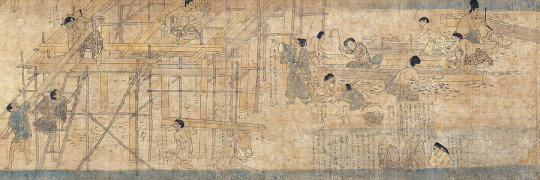
A group of Tengu constructing a temple in the tengu realm (wikimedia commons)
The emergence of tengu as a well defined class of beings is fundamentally tied to portraying them as a source of hindrances for practitioners of Buddhism. In the twelfth century, they came to be identified with the concept of ma (魔), a loanword from Sanskrit māra. In this context, it is to be understood as obstruction of enlightenment, or opposition to the Buddha, his teachings and the Buddhist law. There are both internal sources of ma, like doubt and worldly attachment, and external ones. Tengu, generally speaking, fall into the second category.
Tengu were believed to be reincarnations of those who lack bodhicitta (菩提心, bodaishin), the mindset necessary to pursue enlightenment. Those who become tengu at least nominally follow Buddhist teachings, but fail because of arrogance, greed and other earthly attachments. Those who mislead others by promoting incorrect practices also turned into tengu after death.
Many tengu narratives from the Heian period and the middle ages portray them as possessing extraordinary powers, which they use to trick and mislead monks and laypeople alike. They could be referred to as gejutsu (外術), literally “outside techniques”. A related term is gedō (外道), “outside way”. These labels are not necessarily pejorative, and can refer to any practices which are not strictly Buddhist, for example to Confucian or Daoist ones, and in fact some were integrated with Buddhist practices. However, depending on context other options might be preferable. For example, Haruko Wakabayashi went with “wicked sorcery” in her translation of a Konjaku Monogatari tale in which a tengu poses as a buddha in order to mislead laypeople. However, even if tengu could imitate miracles Buddhas and bodhisattvas were believed to perform, their results were only temporary because they lacked true power. In many tales the effects of tengu tricks only last seven days.
According to the Kamakura period anthology Shasekishū (沙石集), not all tengu are malicious, despite their origin. Those who are close to being redeemed, while held back by “superficial wisdom”, curtail the influence of their more malevolent peers and thus act as protectors of Buddhism. They eventually leave the realm of tengu. Other sources indicate that the malign tengu are destined to eventually be reborn as animals.
As already pointed out above, the notion of tengu being opponents of Buddhism already appears in Konjaku Monogatari, composed between 1120 and 1140. The tales involving them appear in the final chapter of the section focused on Buddhism in Japan, which sets them apart from most other supernatural beings. They are instead grouped with accounts of visits in hells and other realms of rebirth, and with narratives explaining the consequences of accumulation of bad karma.
In the Kamakura period, tengu received their own place in the Buddhist cosmos: an entire realm of rebirth. It didn’t replace any of the three other realms where one reincarnates as punishment due to accumulating bad karma - these of hungry ghosts, animals, and hell. It could be sometimes described as a specific hell (one of many) or as a part of the animal realm, but generally it was held to be something distinct. While still perceived negatively, it can effectively be considered a preferable alternative to rebirth as an animal or in hell, since to be reborn as a tengu does not necessarily prevent one from seeking enlightenment.
The realm of tengu was variously referred to as tengudō (天狗道; “realm of tengu”), madō (魔道; “realm of ma”) or makai (魔界; “world of ma”). The last of these terms has been present in Touhou for a while, though never in association with tengu, at least for now. I am aware many people are attached to the PC-98 portrayal of Makai and to Shinki, but I would argue there are endless possibilities in trying to make the medieval understanding of this term work in this context as well. Most notably, the notion of monks who failed in their pursuit of enlightenment would have interesting implications for Byakuren. Following medieval Buddhist logic, one could argue she is essentially already a tengu, even though ZUN refers to “sealing” in Makai, as opposed to being reborn there. She may deny it herself in Symposium of Post-Mysticism, but it's hard to argue with the evidence.
The oldest work establishing the existence of tengudō as a distinct realm of rebirth is Hirasan Kojin Reitaku (比良山古人霊託; “The Spiritual Oracle of the Old Man of Mount Hira”), in which the Tendai monk Keisei (1189–1268) learns about it from a tengu residing on Mount Hira. While left anonymous, the being states that he was alive in the times of Shōtoku and before the rise of Fujiwara no Kamatari to prominence, and explains that due to worldly attachments he was reborn in the realm of tengudō. He then provides information about many of Keisei’s family members and contemporaries, as well as assorted historical figures. Some of them have shared a similar fate, including emperors Sutoku and Goshirakawa and prominent members of Buddhist clergy like Ryōgen, Jien, and many others. Keisei and the anonymous tengu then engage in what I can only describe as a vintage example of power scaling, and start to compare the strength of the individual tengu (as we learn, Go-Shirakawa is more powerful than Sutoku).
Curiously, the anonymous tengu is entirely self-aware, and explains that his mind is filled with illusory thoughts, but proper Buddhist observance can nonetheless save him and other tengu from their current state. He notes that Ryōgen was able to leave the realm of tengu already, for instance. Another peculiar aspect of this account is the explicit reference to female tengu. The protagonist explains to Keisei that his wife is a fellow tengu, though she is only 400 years old. He also specifies many other tengu have families and even children.

A debate in the tengu realm (wikimedia commons)
The Buddhist views on tengu became firmly cemented thanks to the Tengu Zōshi (天狗草紙), a set of seven illustrated scrolls. This work most likely originally arose in the thirteenth century, in an era of conflicts between the well established esoteric schools of Buddhism, Tendai and Shingon, and the newcomers to the scene, like Zen and Pure Land. All parties involved accused each other of spreading false teachings and embracing ma. The new schools did not form a unified front, for clarity: for instance, Nichiren denounced the Shingon establishment about equally enthusiastically as Zen or Pure Land. There were also voices presenting the very act of criticism of other schools as worthy of critique in itself.
The goal of Tengu Zōshi was to criticize and satirize the various vices of contemporary Buddhist monks by presenting them as tengu. It states that there are seven kinds of tengu, corresponding to seven different sorts of pride (citing Haruko Wakabayashi: “feeling slightly inferior to those who are greatly superior, feeling superior to those who are inferior and equal to those who are equal, feeling superior to those who are equal and equal to those who are superior, feeling superior to those who are superior, being attached to oneself, committing evil and thinking one is virtuous, and feeling enlightened when one is not).
Five of the tengu types are supposed to represent monks of major temples of this era (Kōfuku-ji, Tōdai-ji, Enryakuji, Onjō-ji, and Tō-ji), the remaining two are yamabushi (mountain ascetics) and “recluses” (tonse). However, the scrolls culminate with a reveal that all of the depicted tengu attained salvation and eventually became Buddhas (save for Ippen, who was instead destined to be reborn in the animal realm). This once again puts an emphasis on tengudō not being quite as bad as the other paths of rebirth which should generally be avoided: one has to actually practice Buddhism in some form to get there in the first place, and it is possible to attain enlightenment as a tengu.
The notion of tengudō and tengu being fallen monks did not vanish after the middle ages, and appears for example in some tales about Yoshitsune’s youth and his training with these beings, for instance in the Miraiki (未来記; literally “chronicle of the future”). Therefore, it is safe to say that this is the closest thing to a universal explanation where do tengu come from. However, their history actually goes even further back.
Cats, comets, dogs and kites: the origin of tengu

A tiangou from the Classic of Mountains and Seas (wikimedia commons)
The history of tengu starts in China. At least the history of the name, that is. The word 天狗, which in Chinese is read as tiangou, already occurs in the Classic of Mountains and Seas, probably composed at some point in the second half of the first millennium BCE, either near end of the Warring States Period or in the beginning of the reign of the Han dynasty. While tiangou can be literally translated “celestial dog”, the creature is actually compared to a wildcat with a white head, and makes catlike sounds on top of that. It is also said to repel evil forces. This quality is also reaffirmed by the poet Guo Pu, who additionally states the tiangou is so small that a ruler could either eat it or wear it as a belt ornament to make use of its protection.
Next to this whimsical image of a benevolent supernatural creature, the term tiangou was also used to refer to comets and similar celestial phenomena. This meaning of the term entered Buddhist texts, for example in the Sutra on the Bases of Mindfulness of the True Dharma (正法念處經, Chinese Zhengfa Nianchu Jing, Japanese Shōbō Nenshokyō), tiangou serves as a translation of the Sanskrit term ulka, which refers to meteors. The astral tiangou eventually developed its own supernatural associations in China, becoming a sort of dog-shaped astral demon. I cannot cover this topic extensively here, but you will find plenty of information, including a first hand account of a modern celebration tied to these traditions, in Xiaosu Sun’s article in the bibliography.
The earliest Japanese reference to 天狗 occurs in the Nihon Shoki (completed in 720), specifically in the section recording the events from the reign of emperor Jomei (593-641). The reason why I’m using the kanji here is that the reading is not necessarily intended to be tengu in this case; the gloss indicates it is actually to be read as amatsukitsune, “heavenly fox” (I’ll go back to this term later). However, Haruko Wakabayashi states it’s safe to assume that it was used here in the astronomical Chinese meaning. The passage refers to observation of a comet, which reportedly made the sound of thunder as it passed from east to west.
Some other early references to tengu occur in literature of the Heian period (794-1185). In this context, this term seems to refer to nondescript mountain spirits. They were believed to possess people to make them fall ill or to cause disorder. All around it seems they weren’t really meaningfully distinct from any other beings or phenomena which could be subsumed under the label of mononoke (物の怪), and it's not clear how their name came to be applied to them. In the early twentieth century, the folklorist Kunio Yanagita tried to prove these early tengu might have represented people pushed into the mountains by the spread of a centralized Japanese state. However, this theory never took off. Even some of Yanagita’s contemporaries, especially Kumagusu Minakata, were critical of it, and it’s just a weird curiosity today. Similar assumptions were proven correct in the case of tsuchigumo, and might be correct in the case of some oni tales, but these are matters for another time.
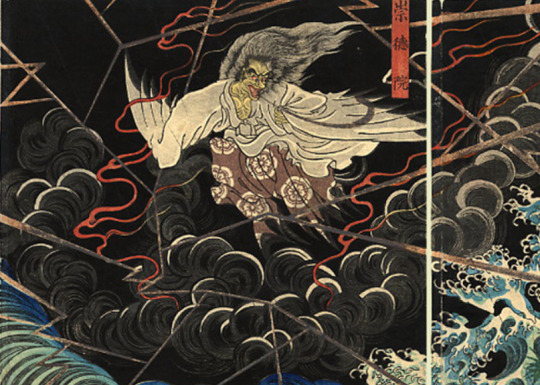
The supernatural form of Sutoku, as depicted by Yoshitsuya Utagawa (wikimedia commons)
Notably, in the Heian period it was already believed that one can reincarnate as a tengu, though this belief didn’t become quite as well defined as it was in later sources. Probably the oldest story like that states that the monk Shinzei (真済; 800-860) a disciple of Kūkai (774-835), became a tengu and subsequently tormented empress Somedono (染殿后; Fujiwara no Akirakeiko), the wife of emperor Seiwa. In later tradition, emperor Sutoku came to be viewed as the archetypal example of a human who reincarnated as a tengu; it should be noted he was simultaneously viewed as a vengeful spirit (怨霊, onryō), though.

A kite-like tengu, as depicted by Sekien Toriyama (wikimedia commons)
The well known association between tengu and birds is already present in Heian sources too. Today, the bird-like depictions of tengu are known as “karasu tengu”, literally “crow tengu”, and in many modern works, including Touhou, this moniker is taken literally. However, through history the birdlike elements of the tengu were typically those of a bird of prey, not a corvid. As I mentioned, kites were the most common, but for example some depictions of Iizuna Gongen are eagle-like. This convention might have been influenced by garudas, a class of bird-like Buddhist protective figures.
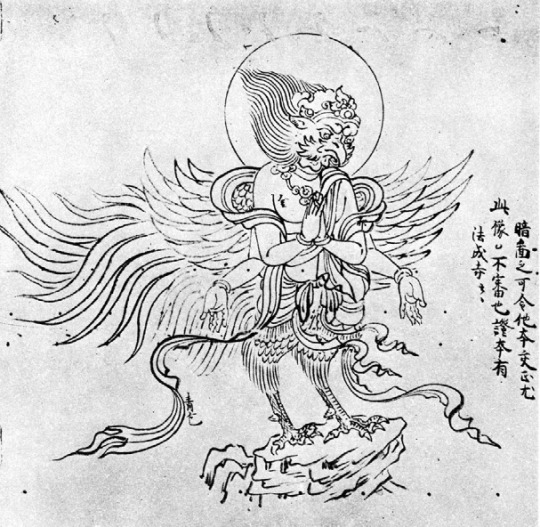
A depiction of a garuda from Besson Zakki (別尊雑記), a Heian period Buddhist iconographic compendium (via Bernard Faure’s Rage and Ravage; reproduced here for educational purposes only)
Descriptions of tengu explicitly mentioning their resemblance to kites are quite common. In Zoku Honchō Ōjōden (続本朝往生伝; “Continuation of the Biographies of Japanese Reborn in a Pure Land Continued”) Ōe no Masafusa (who you might remember from my Ten Desires article) mentions a tengu turning into a kite to spy on a virtuous monk. In the historical epic Taiheiki Sutoku, presented as the ruler of all tengu, is said to have the form of a golden kite. However, in at least some cases tengu are not necessarily birds themselves, but merely use them as mounts. Granted, both traditions could coexist: Hirasan Kojin Reitaku explains that tengu ride kites, but it also describes them as possessing the legs, tail and wings of a bird themselves.
The oldest source to feature a large number of images of bird-like tengu is the already discussed Tengu Zōshi. These include high-ranking monks with beaks, yamabushi or monks with wings and beaks, slightly more bird-like figures portrayed largely without clothing, and finally non-anthropomorphic kites. There are also illustrations of seemingly regular humans labeled as tengu. Haruko Wakabayashi concludes that the use of multiple distinct iconographic types in the same scrolls might reflect belief in a hierarchy of tengu, with the beaked monks representing the upper echelons of the tengu society and the other varieties their servants. The regular kites presumably hold the lowest position. The tengu world thus seems to reflect a contemporary idealized image of Buddhist hierarchy, with lower ranking practitioners, wandering ascetics and laypeople guided by senior monks.
ZUN kept the notion of tengu hierarchy, though the classes listed in the relevant entry in Perfect Memento in Strict Sense are largely his invention, or at least represent pretty extensive reinterpretation (for instance, tengu dressed up as yamabushi aren’t associated with printing in any particular way). While many of these changes work very well with his idea to adapt the traditional role of tengu as peddlers of dubious interpretations of Buddhist doctrine and false miracles with a fresh twist by making them purveyors of misinformation, I will admit I’m not sure where did the idea of wolf tengu come from, as it fits neither this theme nor any genuine tengu background. The wiki insists that’s a reference to the Chinese tiangou, but I’m not buying this.

Iizuna Gongen riding on the back of a celestial fox (wikimedia commons)
I would argue foxes would probably work better than wolves. In some cases due to phonetic similarity a degree of conflation, or at least confusion, could occur between tengu and tenko (天狐), “heavenly foxes”. The fourteenth century treatise Byakuhō Kushō (白寶口抄) states the tenko has the form of a kite, for instance. It’s also why Iizuna Gongen was sometimes referred to as Chira Tenko (智羅天狐). The link with foxes was hardly universal, though. For example, it is absent from the tradition centered on Mount Atago, in which in addition to birds, tengu are associated with wild boars. Note that a myth dealing with Iizuna Gongen’s arrival in Japan does indirectly link this location with foxes, but this is basically extending his own connections to other tengu.
While the discussed animal connections are quite important for tengu iconography, I was unable to find any evidence that there was ever a particularly strong belief in mundane animals turning into tengu, as Aya’s bio from Phantasmagoria of Flower View would imply. The only source I am aware of which would state that directly is Atsutane Hirata, one of the most fanatical kokugaku authors, and even he still states that at least some tengu were reincarnated Buddhists. Note that his works are generally not a record of genuine mythology or folklore, but part of an effort to “purify” Japanese culture which directly led to the birth of the “contemporary” form of expansive nationalism. In any case, Hidden Star in Four Seasons and the historical context of information it provides opens the possibilities for much more interesting and unique tengu backstories than just stage 2-worthy beast youkai fare.
To sum up, while individual stories might portray tengu as arriving in Japan from Korea (Tarōbō), China (Zegaibō and his prototype Chira Yōju) or even India (an anonymous tengu in Konjaku Monogatari), these reflect the routes across which Buddhism was transmitted to Japan. The tengu as a distinct supernatural creature had elements which originated abroad, obviously, but ultimately represented a strictly Japanese contribution to Buddhist demonology. At least some Japanese authors were already aware of this in the middle ages, as evidenced by the Shasekishū.
The three meanings of 天狗 - the tiangou, the astral object and the tengu - are explicitly described as distinct from each other in the encyclopedia Jakushōdō Kokkyōshū (寂照堂谷響集) compiled by the monk Unshō (運敞; 1614–1693). The original tiangou is described here as a type of tanuki which eats snakes, but this doesn’t exactly contradict the Chinese description I’ve mentioned before, as 狸, the character referring to wildcat in Chinese, was adopted to represent the name of tanuki in Japanese. The astral tiangou is described as a “tengu star” (天狗星, tengu-sei) which has the form comparable to a dog. Unshō stresses that both of these are distinct from the Japanese tengu, despite their names being written identically. He places the tengu in the entourage of Mara, alongside dakinis and vinayakas (in this context demons representing something like an evil counterpart of Ganesha as a remover of obstacles).
Beyond animals: the long nose tengu and Sarutahiko
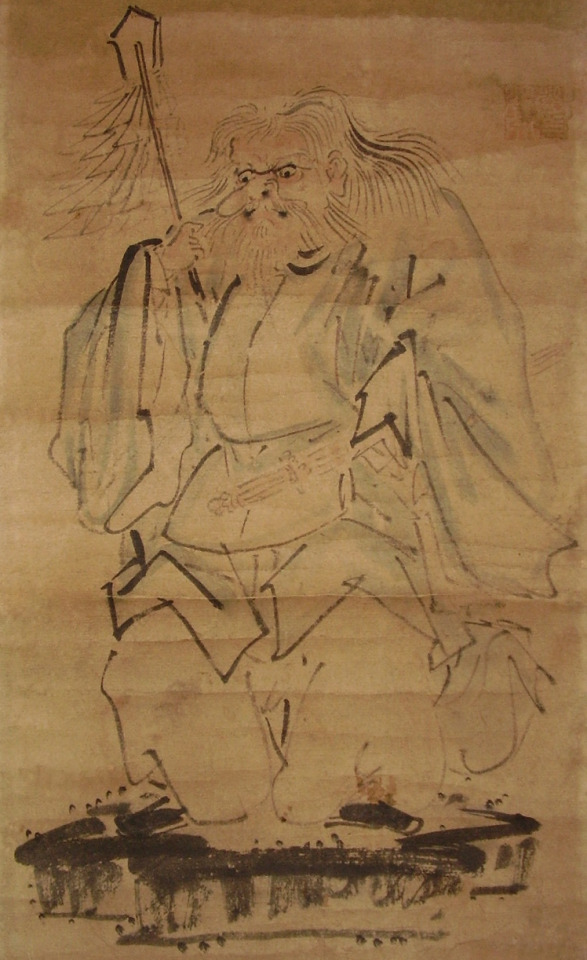
A Meiji period depiction of Sarutahiko (wikimedia commons)
A final matter which needs to be addressed here is a theory that tengu imagery is derived from Sarutahiko, which for some reason has been placed in the lead of the tengu article on wikipedia despite being hardly relevant academically. This proposed connection relies on the fact that from the very beginning Sarutahiko was described as long-nosed. In the section of the Nihon Shoki dealing with the “age of the gods”, the oldest text he appears in, it is said that “his nose is 7 feet long”. His other physical characteristics are also exaggerated, to be fair - he is said to be unusually tall, and his eyes are enormous too. All around, this description is presumably meant to make him seem intimidating. Still, the nose is what visual arts tend to highlight, sometimes for comedic purposes.

A long-nosed tengu, as depicted by Hokusai (wikimedia commons)
This characteristic also led to a development of a folkloric connection between Sarutahiko and the one type of tengu depictions I haven’t discussed yet - the long-nosed tengu, commonly called daitengu or “great tengu”. The origin of this iconographic variant remains poorly understood. While by far the most recognizable today, they are a relatively recent artistic convention - the oldest examples only date to the late fifteenth or early sixteenth century, and they only became widespread in the Edo period. By then, tengu were present in Japan for some 700 years, and Sarutahiko doesn’t come up in sources describing them (and vice versa).
It also needs to be stressed that while the daitengu still have some birdlike traits, Sarutahiko lacks a connection to birds altogether. Instead, he is associated with monkeys (tengu never are, contrary to an unsourced claim on wikipedia). Historically he could even be identified with Daigyōji (大行事), a deity from Mount Hiei depicted with the head of a macaque.
It’s not impossible that the specific long-nosed type of tengu depictions was based on depictions of Sarutahiko, but it’s equally likely the influence actually went into the opposite direction (most depictions of Sarutahiko are from the Edo period or later, and most shrines dedicated to him are fairly recently established too, even though he was worshiped in one form or another through earlier periods already).
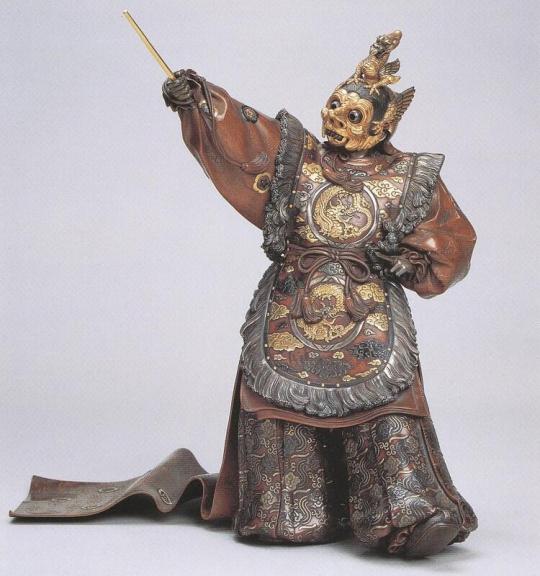
A statuette of a dancer wearing a Raryō-ō costume by Shōmin Unno (Imperial Household Agency; reproduced here for educational purposes only)
Bernard Faure notes it’s also not impossible that both Sarutahiko’s iconography and the long-nosed tengu are simply both reflections of something else altogether, and suggests the long-nosed Raryō-ō (羅陵王; sometimes shortened to Ryō-ō, 陵王) masks used in bugaku performances as one possible candidate. Ultimately none of these possibilities can be proven conclusively, though, and it’s best to maintain caution.
ZUN seems to believe there is some truth to the proposal that tengu were derived from Sarutahiko, judging from the fact he referenced this connection multiple times in various ways. The oldest example are Aya’s spell cards in Mountain of Faith. It also comes up in Symposium of Post-Mysticism, where Miko and Byakuren seem to basically treat it as a fact. Aya in one of the short articles from the same book declares that “when it comes to white beard in Gensokyo, we tend to picture Sarutahiko. (...) he is also the god of us tengu”. Putting aside the latter claim, which is bit of a reach when it comes to real beliefs, it’s worth noting that the mention of the white beard is a pretty deep cut. It was actually not a part of Sarutahiko’s original iconography, but rather an addition which developed at the Shirahige Shrine on the shores of Lake Biwa. Originally the local deity, Shirahige Myōjin (白鬚明神), was considered a distinct figure. However, at some point he came to be identified with Sarutahiko, and the names seem to be used interchangeably in medieval and later sources. As a result, the latter received the former’s signature white hair and beard.
While despite the existence of a genuine connection it is a stretch to call Sarutahiko a “god of tengu”, let alone their leader, this does not mean that figures which can be described this way are absent from tradition. In fact, I mentioned a number of them in passing in the previous sections. However, describing them in more detail a topic for another article. Look forward to "Tenma, boss of the tengu". Exploring the "heavenly demon(s)", coming next year!
Bibliography
Yasurō Abe, The Book of “Tengu”: Goblins, Devils and Buddhas in Medieval Japan
Bernard Faure, Protectors and Predators (Gods of Medieval Japan vol. 2)
Idem, Rage and Ravage (Gods of Medieval Japan vol. 3)
Michael Daniel Foster, The Book of Yokai. Mysterious Creatures of Japanese Folklore
Sarah Fremerman Aptilon, Goddess Genealogy: Nyoirin Kannon In The Ono Shingon Tradition in: Charles Orzech, Richard Payne & Henrik Sørensen (eds.), Esoteric Buddhism and the Tantras in East Asia
Wilburn N. Hansen, When Tengu Talk. Hirata Atsutane's Ethnography of the Other World
Richard E. Strassberg, A Chinese Bestiary: Strange Creatures from the Guideways Through Mountains and Seas
Xiaosu Sun, Liu Qingti's Canine Rebirth and Her Ritual Career as the Heavenly Dog: Recasting Mulian's Mother in Baojuan (Precious Scrolls) Recitation
Haruko Wakayabashi, The Seven Tengu Scrolls. Evil and the Rhetoric of Legitimacy in Medieval Japanese Buddhism
Idem, Monks, Sovereigns, and Malign Spirits: Profiles of Tengu in Medieval Japan
Duncan Ryūken Williams, The Other Side of Zen: A Social History of Sōtō Zen Buddhism in Tokugawa Japan
154 notes
·
View notes
Text
Crack Theory Time for ch. 110
Ok gang, what if ch. 110 has a happier ending? Here's what I think could happen. (Or at least what I want to happen for my ruined heart). Just hear me out.
Aya and Bram save the freaking world. The sword is successfully dislodged and all the vampires go back to normal. That means Chuuya is free! He helps Dazai (who isn't dead come on Asagiri-sensei wouldn't do that to us right? RIGHT)?! Together, Soukoku takes down Fyodor and finally kill him! Sigma finishes processing the info dump he got, Nik gives Dazai the antidote, and they all go home!
Aku is freed from his vampirism and is NOT DEAD because *magic* and *healing powers* from vampirism. He helps Sushi Roll and together they prepare to defeat Fukuchi once and for all.
Without the vampires, Fukuchi has nothing except for Ame no Gozen. Mori finally crawls out of his bunker (or wherever he's hiding) and helps Fukuzawa to safety? Or Yosano shows up and saves our fave dilf. One of the two. (I'd prefer Zenki Soukoku team up but whatever). Fukuchi is defeated and everyone sings kumbaya again because yay! No more bad guys!
obviously, I'm not delusional and surely this is the way Asagiri-sensei intended the story to go because we've been through enough pain already 🤪
#bungou stray dogs#bsd crack theory#dazai osamu#chuuya nakahara#yukichi fukuzawa#ougai mori#akutagawa ryuunosuke#atsushi nakajima#ōchi fukuchi#fyodor dostoevsky#koda aya#bsd bram#akiko yosano#kafka asagiri#make the pain end!#please asagiri-sensei please!#crack theory time
30 notes
·
View notes
Text
Danganronpa:Ransei's Tears
read it on the AO3 at https://ift.tt/eh0H1nG
by Spinnetossa_Shipper
After the great Ransei War, it is believed that peace has returned to the region. However, as the 38 Warlords and Junior Warlords suddenly vanish without a trace, peace seems unlikely. Waking up in an unknown environment, these warlords must now fight for their survival. What will it take for these closely bonded warriors to kill once more?...
(This is more of a Pokemon Conquest centric fanfic so you do not need to be a Danganronpa fan to understand this story)
(First Chapter is an authors note and not part of the story)
Words: 187, Chapters: 1/?, Language: English
Fandoms: Dangan Ronpa Series, Pokemon + Nobunaga no Yabou | Pokemon Conquest
Rating: Teen And Up Audiences
Warnings: Graphic Depictions Of Violence, Major Character Death
Categories: Multi
Characters: Shujinkou | Hero (Pokemon), Shujinkou | Heroine (Pokemon), Oda Oichi, Maeda Keiji, Fukushima Masanori, Ishida Mitsunari, Katou Kiyomasa, Toyotomi Hideyoshi, Kuroda Kanbei, Takenaka Hanbei, Mouri Motonari, Chousokabe Motochika, Tachibana Ginchiyo, Tachibana Muneshige, Imagawa Yoshimoto, Shimazu Yoshihiro, Uesugi Kenshin, Naoe Kanetsugu, Aya Gozen, Takeda Shingen, Sanada Yukimura, Kunoichi (Samurai Warriors), Houjou Ujiyasu, Narita Kaihime, Fuuma Kotarou, Nene | Toyotomi Yoshiko, Hattori Hanzou, Date Masamune, Saika Magoichi, Tokugawa Ieyasu, Honda Tadakatsu, Komatsuhime | Honda Inahime, Saitou Nouhime, Izumo no Okuni, Akechi Mitsuhide, Hosokawa Gracia, Mori Ranmaru (Historical RPF), Oda Nobunaga
Additional Tags: Crossover, Killing Game (Dangan Ronpa), Character Death, Original Character(s)
read it on the AO3 at https://ift.tt/eh0H1nG
0 notes
Quote
Whenever people look at Aya and find out that she's my older sister, I feel like they look back at me and think, "God, what happened to Kenshin? Did he witness a murder?"
Kenshin
#kenshin uesugi#aya gozen#samurai warriors#sengoku musou#incorrect samurai warriors quotes#source: chris fleming
23 notes
·
View notes
Text
[Art] IkeSen OC: Aya Gozen ⛓
Similarly to Hatsume, I had posted a picture of Aya a while back with some vague info about her personality, but I’m glad to finally have enough time to post her entire bio! But before you begin reading, there is slight NSFW ahead, and also the mention of religious piety, so I just want to point out that none of this is meant to offend anyone.
But with that in mind, I hope y’all like her~! 😁💕

((Just a side note, her battle weapon is actually a scythe but I felt too lazy to draw it xD However, in addition to that she also often carries around a riding crop, and is seen with it even outside of battle.))
Name: Aya Gozen/Aya Uesugi
Birthday: July 28 (historical birthday unknown)
Significant Relationships: Kenshin Uesugi (younger brother)
Sasuke Sarutobi (sexual partner and love interest)
Personality: Aya is a pious nun who is known for her straightforwardness, ruthlessness, her iconic “Ara ara/My my~~”, and fiercely violent nature on the battlefield. However, despite her closeness to Bishamonten (name for the God of War, known for punishing evil doers) and strong sense of spirituality, she is most known for being extremely promiscuous, and often uses that along with her motivation to “punish wrongdoers” to lock victims up in a dungeon and “punish” them for their deeds. Being a tall dominant lady (she’s 6’ so she’s TALL), she intrigues yet intimidates the hell out of anyone she meets (especially men), though nobody can really help the feeling of curiosity that attracts them to her, and they cannot help but enjoy the “punishments” they may receive if they happen to be “bad”. Of course, behind her harshness and cheeky seductiveness lies a lonely woman who longs for that special someone to have a family with, and while she may not admit it, her “punishments” are a way to determine who is suitable enough to fill the hole in her heart. All she needs is a spark of compatibility to know.
Backstory: As a child she had always been very cheeky, constantly teasing her younger brother Kenshin in any way possible. She also enjoyed sparring with him too, and being the taller one, she usually had an advantage over him (still does xD). But in addition to gloating about it, she also helped him learn new techniques, which he still uses to this day (despite insisting that they’re useless). Because of how much she cared for her brother, she developed the longing for wanting a child to care for as well, and she began to explore her womanhood when she got older. Of course, nobody really fit her very high standards of the ideal “Mr. Right,” until the faithful day that Sasuke showed up.
Relationship with Kasugayama Warlords + Mitsuhide + Kennyo:
Kenshin: These two have a very complicated relationship that one could mainly describe as love-hate. The two of them don’t get along very well, usually due to Aya’s teasing and Kenshin’s short temper, and they end up sparring for hours without tiring. They also fight over Sasuke; Kenshin gets annoyed with the fact that she serenades his vassal while she on the other hand mocks him by stating that Sasuke likes her more (which he does but Kenshin would have his head on a plate if he found out). When they do get along however, it is incredibly hard to believe due to how rare it is, but it’s wholesome nonetheless (aside from the fact that it’s usually got to do with murder but I digress).
Shingen: When it comes to Aya and Shingen, it comes as an astonishing surprise that they are merely just friends and nothing else. You’d think that putting the suave Casanova and the erotic bombshell together in a room would make for a recipe for lusty lavishing but that’s not the case for these two. When they spend time together their flirtation is replaced by their intellect and they could talk for hours. Because of this, people assume that they are a couple, though the two of them just ignore those rumors.
Yukimura: He gets frustrated whenever she flirts with Sasuke and often tries to protect him from her. His actions are mainly because of his own fears of any potential harm she could inflict on him, given her reputation. However his worries are often left looking irrational due to the fact that she doesn’t pay attention to him much, which is evident in the fact that she calls him “kid” instead of his name. Though he does get red in the face when she does call him by his real name.
Sasuke: Ever since their first encounter, Aya’s curiosity skyrocketed like crazy and she began to wonder if he was really fit to be Kenshin’s vassal. So in order to prove that, she challenged him to a spar; if he won he would face no consequences, however if she won, she would get to “punish” him. Since Sasuke had already heard about her “punishments” he made sure to do his best and ended up winning. Shocked but even more fascinated, she continued to challenge him to spar, but overtime the interest he’d sparked in her slowly turned into something romantic. She comes up with excuses to give him “private lessons” in the dungeon and often teases him and tells him that she wants a family with him (though she may be a tad serious about that too.) When it comes to Sasuke, he is very confused as to why he is her main target but doesn’t complain. He can’t deny that he finds her intimidating yet extremely mystical, but often can’t help but blush around her. He also very much enjoys “private lessons” but never says so aloud, though it’s pretty easy for Aya to tell and she uses it to her advantage. While it may be unclear to Sasuke, Aya effectively hides the fact that she sees him as the “Mr. Right” she has been searching so long for, and is definitely in love with him.
Yoshimoto: Similarly to Aya’s relationship with Shingen, her relationship with Yoshimoto is a very civil and respectful one. She respects him for his intelligence and artistic views while he admires her for her elegance, beauty, and fighting skills.
Mitsuhide: While the two of them haven’t had many nor long encounters, they encounters that they’ve had have always intrigued them. They don’t talk much except for a few short sentences, and all of them are witty responses to the last. So in conclusion, they aren’t exactly friendly, but instead have a rather interesting acquaintanceship.
Kennyo: As a monk he quite frequently sees her praying at the shrine, but despite this pious act of hers, he is aware of her reputation as the fierce and promiscuous older sister of Kenshin Uesugi, the Dragon of Echigo. Being the sharp witted woman she is, she is aware of his suspicious nature, but is very good at hiding it. The only times they’ve talked have always been a greeting as they walk past eachother with wary sideglaces.
#ikesen#ikemen sengoku#ikesen oc#ikemen sengoku oc#original character#oc#ikesen aya#aya gozen#ikesen kenshin#ikesen shingen#ikesen yukimura#ikesen sasuke#ikesen yoshimoto#ikesen mitsuhide#ikesen kennyo#ikesen art#ikemen sengoku art#digital drawing#digital painting#digital art#digital illustration#uesugi takeda forces
26 notes
·
View notes
Photo








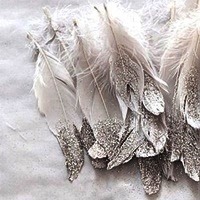
happy holidays @water-ring! I was super excited to see Aya on your wishlist, so I made a moodboard for her. I hope you like it!
10 notes
·
View notes
Note
if you're still doing that ship + five sentences thing: "why would you do this??" for aya x kanetsugu
Aya felt herself shifting before she woke proper, the side of her cheek brushing against an unfamiliar fabric. Her first thought was, when had she fallen asleep, before she felt the arms wrapped around her.
Panic snapped her eyes open in time for her to look up into Kanetsugu’s face, as he realized that she had woken. He was... carrying her?
“Kanetsugu, explain yourself,” she said, arching a brow. Although she made no move to break out of his hold.
“I’m - I’m sorry, my lady,” he stammered, his face flushing several shades pinker than normal. “I found you asleep in the castle library, and it didn’t look terribly comfortable, and I thought-”
Aya held up her hand, gently pressing a finger to his lips. “No, Kanetsugu, I meant, why this?” A sleepy fogginess was still clouding some of her mind, but she had enough thought to wonder aloud, “You could have simply shaken me awake, or had Kadabra use its powers to help you if you were so insistent on bringing me back to my rooms. I do certainly hope Kenshin hasn’t seen us like this.”
She felt him tense at that last part, and Aya gave a soft chuckle. “But, by all means. Now that we’re here,” she continued, leaning her head into Kanetsugu’s chest. “Go on.”
He looked down at her in his arms, as if only just now comprehending what he had actually done. “I...” He drew in a deep breath, the rise and fall of him against Aya more comforting than she had expected to find. “I care, my lady. That is why.”
#pokemon conquest#aya gozen#kanetsugu naoe#aya x kanetsugu#oof been a while since i wrote anything not painful for these two#fashionablyfyrdraaca#it's a complicated russian novel#my writing
9 notes
·
View notes
Text
Hey, Cybird...
Since we didn’t get Kichō as a woman... Maybe... Just maybe...
Let us have Aya Gozen as a love interest, instead?
One female love interest would not hurt.
Just saying.
18 notes
·
View notes
Text
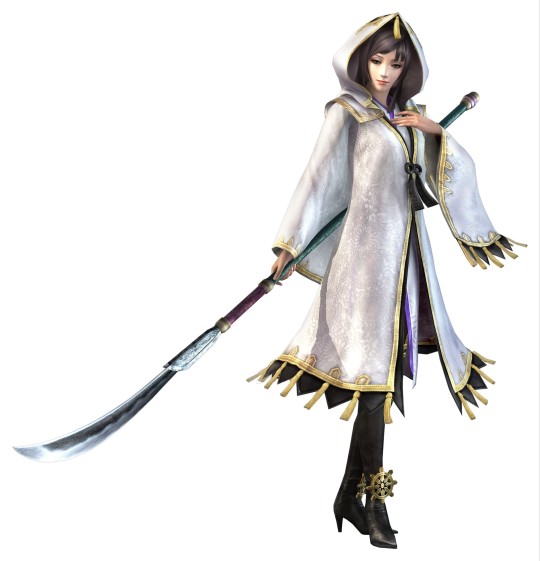
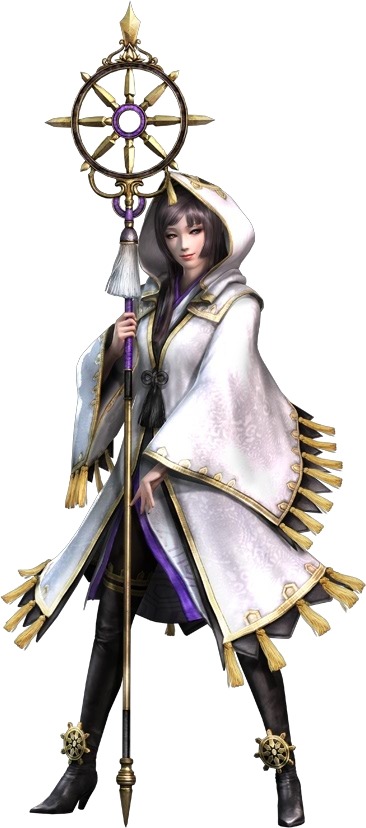
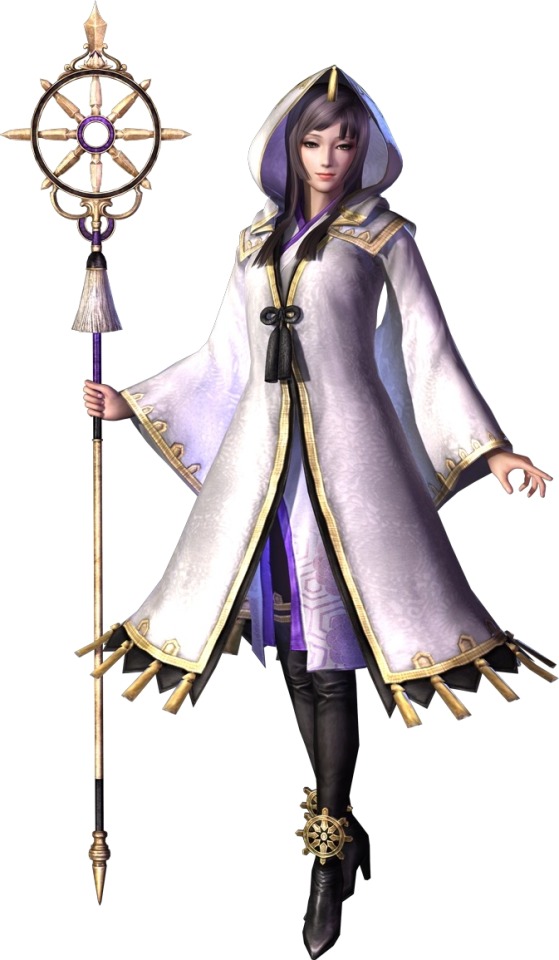

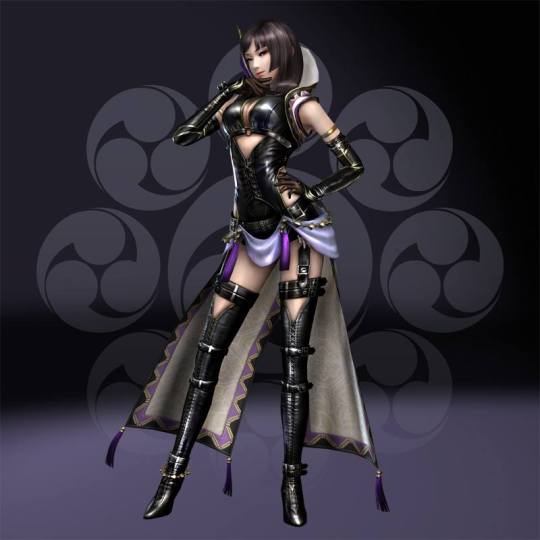

Aya is probably the most Underappreciated/Underrated Female Musou Characters IMHO
8 notes
·
View notes
Photo






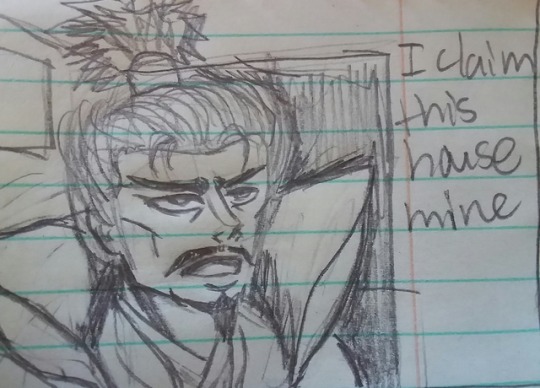
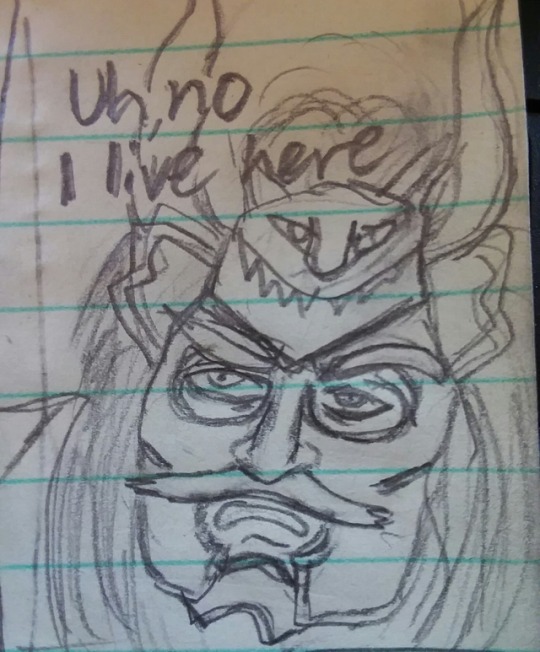
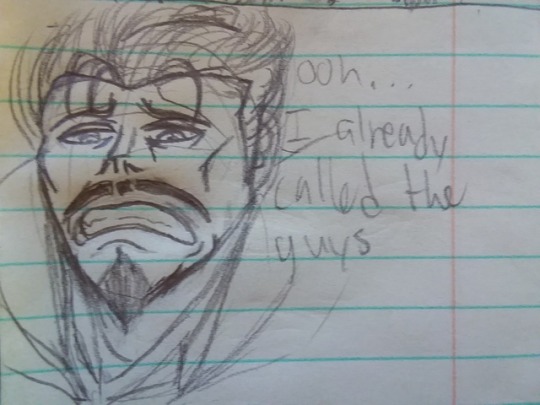
i have some samurai vines
#dumb shit#samurai warriors#sengoku musou#kojuro katakura#masamune date#aya gozen#ujiyasu hojo#nobunaga oda#shingen takeda#some of them are rare#my sense of humor is only vines now#the oda shingen one is based off the nagashino battle
41 notes
·
View notes
Text
Aya: Glasses are so unattractive😩😩😩💔
Kojuro: we just tryna see, damn
5 notes
·
View notes
Photo

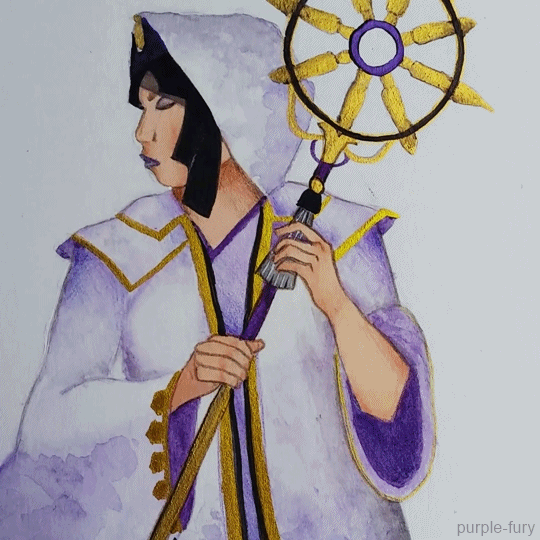
Here’s Samurai Warrior’s Aya, part of an art trade with @ayauesugi! I wanted to highlight the staff, so I kept this relatively simple. Hope you like it!
#samurai warriors#warriors orochi#aya#aya gozen#watercolor#fury arts#I added a gif to show the shine!
18 notes
·
View notes
Photo

the uesiblings but if they swapped portrait art, expressions and all
#samurai warriors#samurai warriors 4#kenshin uesugi#aya gozen#koei#dollhouse's art#{ wont you look at that#kenshin's >: < swapped w aya's ówò }#{ kenshin looking serene is fucking weird but so is the original portrait's pose like aya is ur back okay?? }#{ and aya in kenshin's portrait is kinda empowering and hot }#{ but then again kenshin's portrait is my top favourite bc .....the Pose™....the Composition™.....anyone wouls feel empowered in that pose
34 notes
·
View notes